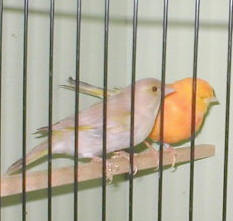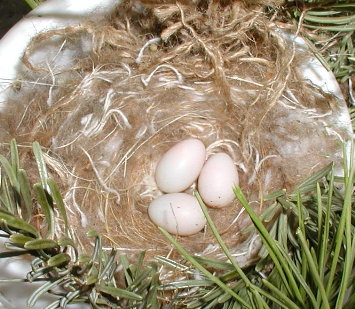
MONTH BY MONTH MANAGEMENT
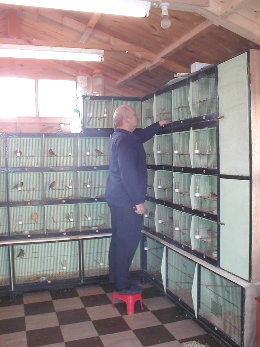
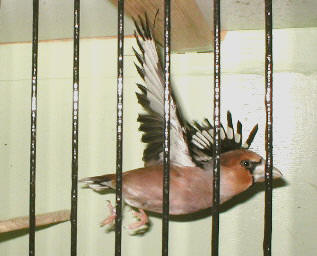
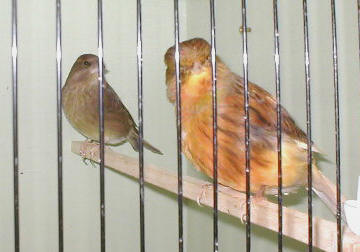
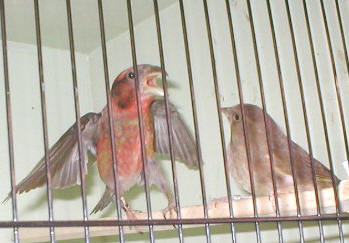
JANUARY
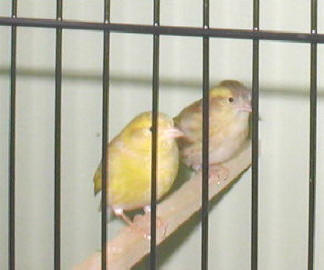
Quiet month this, other than there are still major shows to attend. I give no extra food other than a basic seed mix and fresh water, I prefer to let the birds have a hard month. I don't starve them but I cut things down considerably, a good time to do all maintenance to cages and bird room. Remember to order your rings early for your straight breeding pairs of British. The sizes you require can be purchased from the British bird council, a link to their website is on my links page. On that site there is a chart showing the sizes required by law in the UK for the particular species, these rings must be fitted when the young are approximately 5 days old, but this varies from specie to specie and depending on how well the young are being fed.
FEBRUARY
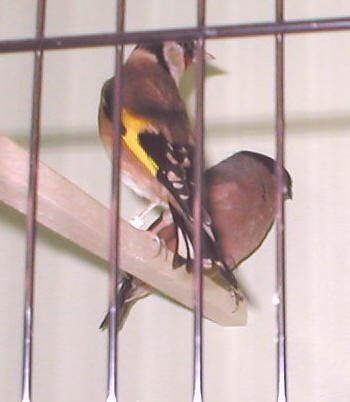
MARCH
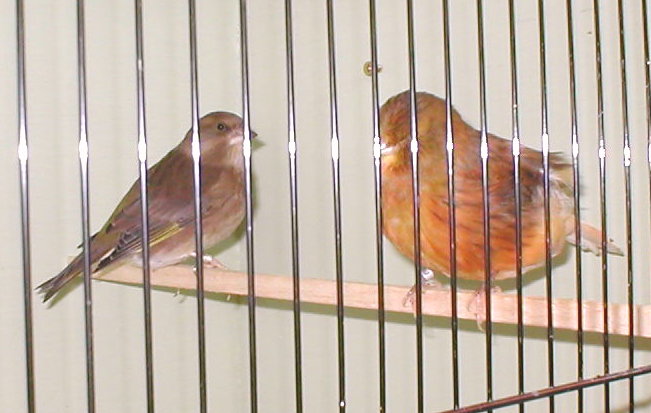
APRIL
Add the nest sites and nest material. Continue to feed the same as March. If birds have been split reintroduce them by the end of April, if pairs don't seem to be doing anything split them up again for another week or so, remember that some species don't come into breeding condition until May. Goldfinches are always later but greenfinches are early nesters. I find that most species come into condition about a month earlier than their wild counterpart. Canaries, by this time, should be chipping there first clutch and if you have already ear marked any for muling now is the time to try to reintroduce the finch cock, if he helps and does not interfere leave him there, if not place a wire slide between them so they can see each other. When the canary hens are ready to go to nest again let him in to the hen morning and again at night. Eggs should be removed early every morning and replaced with dummies. I then use the eggs under foster pairs to rear them, usually the first round I split half and half, this gives me a better chance of rearing some, also it proves out my breeding pairs to make sure that they will rear their own.
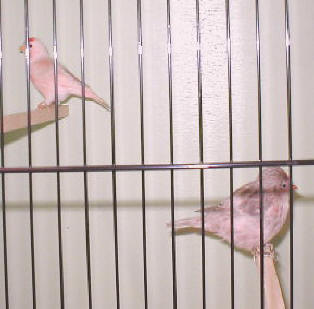
MAY
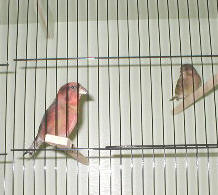
By this time you should have some young, also plenty of hard luck stories and plenty of nightmares. This is the time to put months of planning in the bin and start again, its not too late!!! Some of your plans will not go as expected, a cock in one cage is displaying to a hen in another or a hen wont have anything to do with her mate, now is the time to spit the pair and try another bird. Swap things around, this is when you breed something you hadn't planned, but better breed something than nothing, and you may be surprised. This action could produce your best bird of the season. The art is watching your birds, don't interfere too soon or keep swapping and changing but don't be afraid to do so if things go wrong, or if a pair seem totally incompatible. Young birds should be moved as soon as they are eating at about 24 days, I then put them in family groups. Try to upset them as little as possible, when moving them I always put my young finches and mules on a sulpha drug until they have finished their first moult.
JUNE
At this time or even earlier, you should have young ready to bolt the nest. If the hen starts to carry nest material add a new nest site and nesting material, otherwise she may try to lay in the old nest. If she does, just remove the eggs as normal and replace them with dummies, let her go fully broody before replacing the clutch, this will help stop the young from destroying the eggs or disturbing the hen. If necessary swap the eggs with a clutch from a proven foster pair, it doesn't matter as much if these eggs are disturbed. you can always swap back once the young have been removed. When the young are split from their parents they should be given soak seed, egg food and fresh greens twice a day at least. At the end of the month it is wise to prepare to colour feed any young that are 7 or 8 weeks old, especially if you intend to show them. I colour feed all my mules and hybrids whether they are of show quality or not. Birds do change when they have moulted, they look better when colour fed, even if you are getting rid of them, colour feeding makes them more saleable, it also helps to sex certain species.
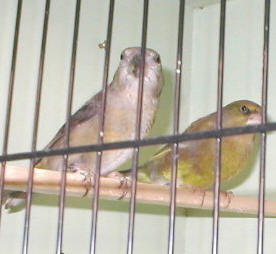
JULY
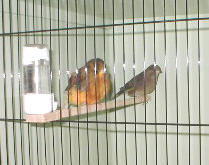
This is probably the busiest month in the season. You will have young and eggs, birds moulting and weaning, and hopefully every cage will be bursting at the seams, yellow mule cocks everywhere, rare hybrids, 50 unflighted yellow Norwich hens, no buff cocks and enough young feeders to replace the older pairs. Next year at last you are self-sufficient "if only breeding mules were that easy". You will think the birds are getting tired but you are probably the tiredest of them all and getting rather fed up of all the hard work, especially if youíre having a bad season and the grass needs cutting and the house needs painting and you really need a holiday. But this is the time when you may just breed that one hybrid you have been dreaming of, this is the month when the unexpected can and often does happen, so see it through, not long to go. If pairs have really done well for you and bred 2 or 3 rounds of young then now is the time to split them, have one last clutch of eggs and let the feeder canaries rear them.
AUGUST
All birds should be split up now and in full moult, this normally takes about 7 or 8 weeks to complete. Adult birds will replace every feather but young birds will only moult the body and head, they will not moult there main flight feathers or tail, that's why they are called unflighted and next year, after they have moulted there flight feathers, they are called flighted. Colour feeding should be well under way. I use carophil red, this is a red powder, I put one level mustard spoonful in a litre plastic bottle and pour some boiling water on it, leave for 24 hours then top up the bottle with cold water, the water should then be a rich red. This is then given to all the birds you want to colour feed, don't feed it to green series birds like greenfinches and siskin, only to brown series birds like redpolls, linnets, goldfinches bullfinches, even give it to bullfinch hens, they will not turn red but the body colour will look richer and the black will take on a rich sheen, so its worth doing. All your Norwich canaries will look better colour fed, because young birds don't moult the wing and tail feathers, these feathers will show no colour. If buying birds this is the best way to know that the birds you are buying are unflighted.
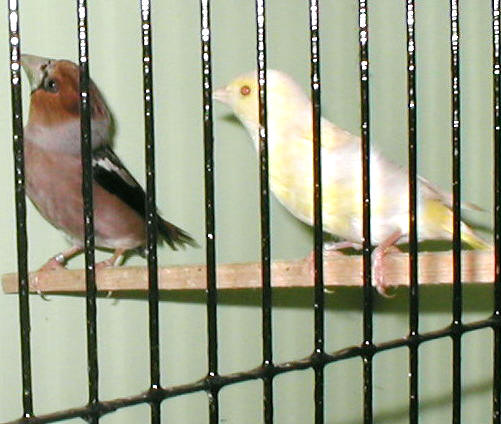
SEPTEMBER
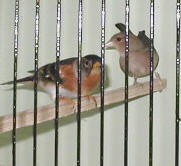
It is best not to disturb birds too much during the moult. Give baths regularly but don't leave them on, in case the birds use this water to drink, and not the colour food, as the birds will come through patchy. The mix must remain constant all through the moult until the colour reaches the head when just the head is left to moult. This is the last part of the body to moult, you can ease off the strength. Spraying your birds also helps to stop the new feathers from come through dry and brittle and helps the birds have a quick and easy moult. Continue to give your birds extra vitamins and minerals and green food. Moulting takes a lot out of the birds so we have to give plenty back at the end of this month. The sweeping up of feathers should start to decrease and most birds should be back on plain water. You will start to see the good and the bad birds that the season has produced. This is the best and sometimes the worst time of year, especially if you have no young birds showing any promise.
OCTOBER
October is the month when you can start to sort out the birds that you want to show or keep. Also time to prepare for your first show. The birds you intend to show should be separated in clean cages and given baths daily, also it is wise to keep them on colour food so that any feathers that are dropped will be coloured. It is wise to train your birds to use training cages. Fix training cages to the outside of the cage so the doors line up, add tit bits in them to encourage the birds to go in. If the cages are all wire the birds soon get used to them, and like to be in them because they can see all round, then when you put a stick into the cage the birds will go straight into the show cage to get out of your way. You can then put the show cage on a shelf while you tend the rest of the birds. The final part of a birds training is to take it to a local show. A one day event is ideal, so that the birds don't have far to travel and are only out for one day. All birds benefit from this training.
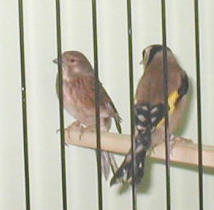
NOVEMBER
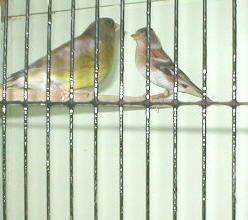
November is the month when all the major British shows start, these shows are spread out all over the country so the birds have to be used to travelling, also the time the birds are out of the shed is at its maximum, so the training done at smaller shows will now pay dividends. This is the time when the mules or hybrids that you bred, now earn their keep if they were bred for showing. Mules and hybrids get better each year so don't worry if in their first year they do not win everything, as long as they are thereabout. Also remember that if your bird wins the best unflighted awards that year, the competition will get much harder next year, first year birds only need to beat that years birds but once shown in the adult classes they will come up against the best birds bred for several years. Always remember that there has to be losers. No man has ever won every show so we all loose, and the occasional win is then very special. There is more than one size of show cage, different species are shown in different cages, these sizes can be seen on the British Bird Council website there is a link on my links page.
DECEMBER
By December the weather is getting colder. Personally at this time of year I heat my birdroom a little. I use an electric thermostatically controlled greenhouse heater; it does not use vast amounts of electric and is only set on frost level. It just stops the water pots from freezing and never actually warms the room. I find the cold does the birds no harm but lack of water does, otherwise I would be defrosting pots all day. If itís a really cold spell I feed extra fatty foods at this time of year including suet and groats, not in quantity but occasionally as a tit bit, no green food is used this month. The occasional small piece of broccoli though, perhaps once or twice a week does no harm, but the diet other than that, is kept very plain. There is little else to do in the bird room other than maintenance and shows. Christmas is busy enough.
